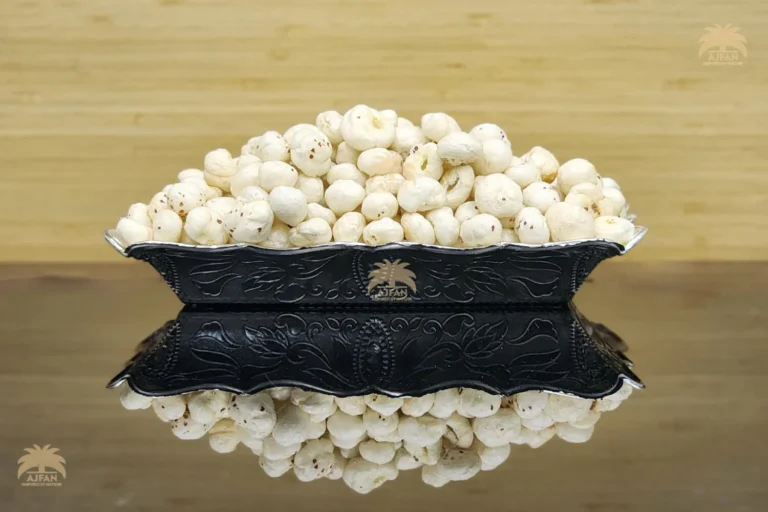Makhana, also known as foxnuts or popped lotus seeds, has gained popularity as a nutrient-rich superfood in recent years.
Prized for its light, crunchy texture, and impressive nutritional profile, makhana offers a healthier alternative to traditional snacks.
But what truly sets it apart is its journey from water lily ponds to your pantry.
With that in mind, let us talk about how makhana is made.
The Process of Making Makhana
The first thing we want to do is discuss the process of making Makhana, which includes the following steps:
- Cultivation and harvesting
- Cleaning and drying
- Grading
- Roasting and pooping
- Packaging and distribution
Step 1: Cultivation and Harvesting
Farmers meticulously cultivate and harvest makhana seeds from water lily plants in ponds, primarily located in Bihar, India.
They begin the process in December, with the harvest season peaking between August and October.
As the water lily fruits burst open, they release seeds into the pond.
Skilled farmers then collect these seeds manually from the pond bed, a labor-intensive task that ensures the seeds’ quality and integrity through traditional methods.
Step 2: Cleaning and Drying
After harvesting, workers thoroughly clean the seeds to remove impurities like:
- Dirt
- Shells
- Mud
They then sun-dry the seeds to reduce their moisture content to about 31%, which is crucial to prevent spoilage and maintain their quality.
During temporary storage, they periodically sprinkle the seeds with water to keep them fresh, ensuring they remain suitable for further processing.
Step 3: Grading
In this essential step, workers sort the seeds based on their size.
The grading process guarantees uniformity in roasting, which directly influences the quality of the final product.
Larger seeds are generally preferred because they yield better results during popping.
Step 4: Roasting and Popping
Roasting and popping define the transformation of raw seeds into a crispy, nutritious makhana snack.
Workers roast the seeds in traditional cast iron pans over stoves called chulhas, maintaining temperatures around 250°C.
After roasting, they manually pop the seeds using a wooden mallet known as a thaapi. Finally, they polish the popped seeds to enhance their visual appeal.
Step 5: Packaging and Distribution
After polishing, workers sort, pack, and prepare the makhana for distribution.
Depending on market demand, they either sell them to traders or deliver them directly to consumers.
Proper packaging is crucial for preserving the freshness and crunchiness of makhana, ensuring it reaches consumers in optimal condition.
The Nutritional Profile of Makhana
| Nutrient | Popped Seeds (Raw Makhana) | Roasted Seeds (Makhana) |
|---|---|---|
| Fat (% by weight) | 0.5 | 0.68 |
| Protein (% by weight) | 8.7 | 14.57 |
| Carbohydrates (% by weight) | 79.8 | 79.4 |
| Phosphorus (mg/100g) | 53.2 | 56.4 |
| Potassium (mg/100g) | 42.0 | 47.2 |
| Iron (mg/100g) | 1.4 | 12.7 |
| Calcium (mg/100g) | 18.5 | 19.2 |
| Magnesium (mg/100g) | 13.9 | 26.3 |
| Sodium (mg/100g) | 71.0 | 23.8 |
| Copper (mg/100g) | 0.5 | – |
| Manganese (mg/100g) | 1.3 | – |
| Zinc (mg/100g) | 1.1 | 1.8 |
Makhana is packed with essential nutrients, making it a superfood that truly stands out among other nuts and seeds.
These popped lotus seeds are rich in protein, fiber, and vital minerals such as:
- Magnesium
- Potassium
- Iron
One of its standout features is the protein content, which is significantly higher than that of popular nuts like almonds and cashews, making it an excellent plant-based protein source for vegetarians and vegans.
- High Protein Content: More protein than almonds and cashews, ideal for vegetarians and vegans.
- Low Glycemic Index: Helps maintain stable blood sugar levels, making it a great option for diabetics.
What truly differentiates makhana is its abundance of essential amino acids, flavonoids, and alkaloids, which offer various health benefits:
- Helps reduce oxidative stress, protecting against chronic diseases.
- Supports the body in reducing inflammation and lowering cancer risks.
- Potential to manage glucose levels, beneficial for diabetes control.
Moreover, makhana’s impressive nutrient profile contributes to overall health:
- Heart Health: Supports cardiovascular wellness.
- Digestive Health: High fiber content aids in digestion.
- Weight Management: Low in calories yet high in fiber, making it a filling and nutritious snack.
Interesting Fact: India is currently going through a food waste crisis that significantly damages its production.
Why Makhana is Considered a Superfood
The rise of makhana as a superfood is attributed to its impressive nutritional profile and its versatility as:
- Gluten-free
- Low-fat
- Nutrient-dense
With the increasing shift towards health-conscious eating, makhana stands out as a nutrient-rich alternative to processed snacks.
Let’s see the reasons that make makhana a popular choice among nutrition enthusiasts:
Health Benefits Supported by Research
Studies have shown that makhana is more than just a tasty treat, it is packed with health-boosting properties:
- The presence of flavonoids and alkaloids in makhana provides antioxidant benefits that help neutralize free radicals in the body.
- Its natural compounds have anti-inflammatory properties that can support joint health and reduce inflammation.
- A high magnesium and potassium content helps in regulating blood pressure, reducing the risk of cardiovascular diseases.
- Its high fiber content and low-calorie density promote a feeling of fullness, aiding in weight control.
- The fiber in makhana supports digestive health by improving bowel movements and reducing constipation.
Versatility in Culinary Uses
One of the standout features of makhana is its culinary versatility.
It can be enjoyed in various forms, making it a popular ingredient in both traditional and modern recipes:
- Roast and spice makhana lightly to transform it into a crunchy, flavorful snack, perfect for those who enjoy savory treats.
- Use makhana to make traditional Indian desserts like kheer (a rice pudding), laddoos, or energy balls for a nutritious and tasty treat.
- Its light, crispy texture makes it an ideal addition to salads and soups, adding a nutritious crunch.
Popular Ways to Enjoy Makhana:
- Roasted with spices like black pepper, chili powder, or chat masala.
- Coated in honey or jaggery for a healthy sweet snack.
- Used as a base in nutrient-dense energy bars or granola.
Why Makhana is a Guilt-Free Snack
Unlike other nuts such as cashews and almonds, which are higher in fat, makhana has a significantly lower fat content.
It makes it a guilt-free indulgence for those trying to cut down on calories and fats without compromising on flavor or nutritional value.
The Benefits of a Guilt-Free Snack
Now let us address the benefits of guilt-free snacks:
1. Low in Saturated Fats
Makhana is naturally low in saturated fats, making it an ideal snack for those looking to support heart health.
Unlike many processed snacks, which are loaded with unhealthy fats that can raise cholesterol levels, makhana offers a lighter, healthier alternative.
Consuming foods low in saturated fats can help reduce the risk of heart disease and promote better cardiovascular function.
Its low-fat content makes it a great choice for weight management, allowing you to indulge without the worry of consuming excess calories.
2. High in Essential Amino Acids
What sets makhana apart from other snacks is its rich content of essential amino acids, which are crucial for muscle repair and growth.
These amino acids help in building and maintaining lean muscle mass, making makhana a fantastic post-workout snack.
For fitness enthusiasts and athletes, the high protein and amino acid profile can aid in faster recovery after intense exercise sessions.
Including makhana in your diet ensures you’re getting the nutrients needed to support muscle health without relying on protein bars or shakes that often contain artificial additives.
3. Natural and Preservative-Free
One of the biggest advantages of makhana is that producers typically prepare it with minimal processing and without preservatives.
Unlike commercial snacks that manufacturers fill with artificial flavors, colors, and additives, makhana retains its natural integrity.
That means you can enjoy a nutritious snack that is free from chemicals and additives, making it suitable for those following a clean eating lifestyle. Plus, its natural preparation method helps retain its nutritional value, ensuring you get the full health benefits in every bite.
The Bottom Line
The future of makhana as a global superfood looks promising. As more people discover its health benefits and versatility, the demand for makhana is likely to grow.
Continued research into its nutritional value and sustainable farming practices will further solidify its place in the superfood category, offering a healthier snack alternative for generations to come.

